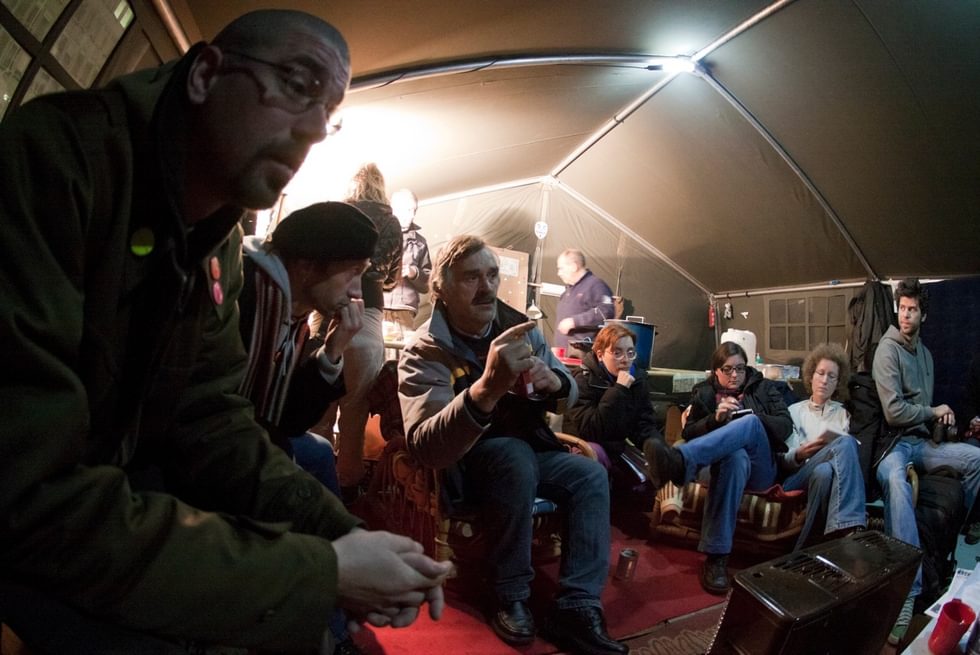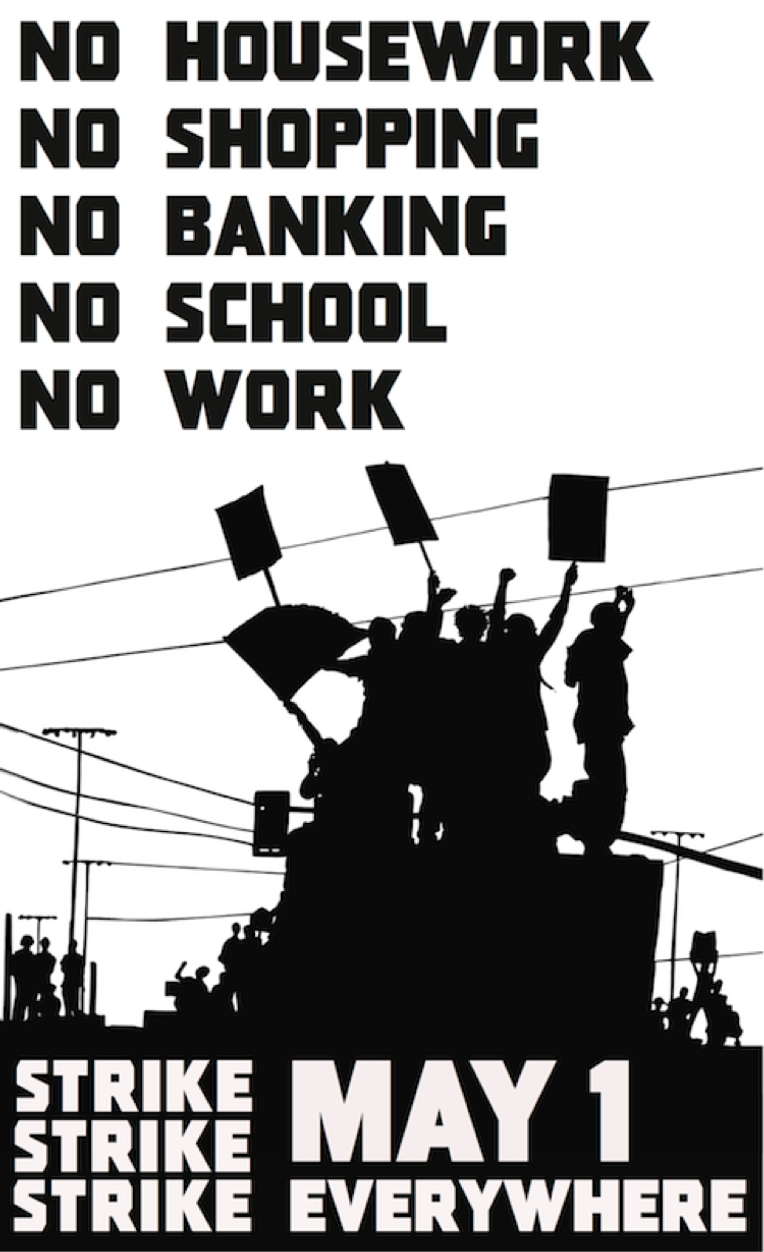May Day, Precarity, Affective Labor, and the General Strike
From the Series: Occupy, Anthropology, and the 2011 Global Uprisings
From the Series: Occupy, Anthropology, and the 2011 Global Uprisings

“The beginning is near.” More than a hopeful slogan, the heady sense of new beginnings for the Occupy movement in multiple, unexpected spaces and social locations was expressed by a day of action on May 1 in New York City as tens of thousands participated in the Free University, neighborhood teach-ins, small actions, and a large spirited rally and march from Union Square to the financial district. Leading up to the actions organizers debated the usefulness of an ambitious call to “strike everywhere,” a call that included, in theory, the cessation for one day, not only of paid work, but of housework, shopping, banking, and school.

The call for this broad “general strike” was one in a series of Occupy-related attempts, with varying degrees of success, not only to rethink but also to enact a new radical vision of the working classes’ nuclear option, attempts that reference earlier periods of working class solidarity and militancy in the U.S. The date itself attempts to revive in the American political consciousness the 1886 strike for the 8 hour day—a militant cooperation between AFL, members of the Knights of Labor and radical anarchists in Chicago—an event that along with the subsequent execution of the Haymarket martyrs is nearly universally forgotten by Americans, despite being an official workers’ holiday in many other countries. In this tradition, immigrant rights organizations used the Spanish-language press to launch “A Day without an Immigrant” on May 1, 2006, building a coalition of immigrant workers, students, and immigrant-owned businesses that surprised readers of the English-language press with its scope and success.
Since then, renewed conversations about the general strike as a tactic picked up with the labor and working class push-back against Governor Scott Walker’s union-busting in Wisconsin, leading to an ongoing conversation between liberals and radicals in the generally progressive but decidedly legislatively oriented Nation Magazine. Oakland’s one day “general strike” last fall sparked debate about the use and abuse of property destruction as a tactic, but only a small amount of conversation about what might be entailed in calling for and organizing a general strike that would go beyond symbolizing the actual and potential social power of the working classes and instead enact that power.
Classically conceived, general strikes have expressed working class power primarily through the withdrawal of productive labor city- or nation-wide. The classic general strike might be divided into two categories—“horizontal” and “vertical.” Horizontal general strikes have been often “sparked” by a group of (usually male) workers located at a critical economic location, such as dockworkers, then becoming generalized as workers strike in solidarity with one another. Vertically organized general strikes, in contrast, called by the leaders of large labor organizations (like public sector workers’ unions in Spain) and organized in a top-down fashion. Both kinds of strikes have been effective at shutting down cities, winning higher wages for workers, sparking policy reform and upsetting the balance of power between the 1% and the rest. But a closer reading of the history of “horizontal” general strikes—through a feminist framework—can add depth to occupiers’ attempts to reinvigorate and redefine the general strike as an action that goes beyond wage labor, to include unpaid care giving and consumption, and one that can help us both to imagine and to actually enact “another world.”
After decades of low levels of workplace struggles, this ongoing attempt to renew and rethink the general strike in the occupy era is startlingly ambitious—activists and intellectuals are attempting to bring together—both conceptually and politically—the employed, unemployed, young, old, student, worker, citizen and immigrant across divides of ethnicity, region, income, race, and gender. A general strike in this expanded sense has never been successfully implemented.
If we take the general strike seriously as a goal of the Occupy movement (and we should), May 1 in New York (and around the country) was a step in the right direction, but by no means the realization of the goal. Surveying my students, most of whom are full-time workers, it became apparent that they, like me, spent the day in a bifurcated world: from 9-5 it was business as usual with little to no disruption of school, work, or shopping. After work, we went to Union Square where we became part of Occupy in action and a large, vibrant march, but where there was little evidence of disruption of the status quo.
Just as it is not enough to make gorgeous posters calling for a general strike (or another world), it is also not enough to merely point out the ways our attempts have thus far fallen short of some historical ideal. In groping toward something genuinely new, I would like to suggest that we closely examine the barriers to participation in the general strike for even sympathetic folks, and think deeply about what is being asked of 99%ers when we call for “no work, no school, no shopping, no banking, and no housework,” and what it would take to actually achieve that.
The calls to abandon housework and shopping as part of a “general strike” are in some respects genuinely new; while women and homemakers have to varying degrees and at varying times participated (occasionally as equal members) in labor organizations and labor protest, and while paid caregivers, educators, and other members of the feminized, affective wage labor force continue to be at the leading edge of labor protest in the neoliberal era, the novel rhetorical equality in OWS’s vision of the general strike between what Hardt and Negri call “affective” labor (what feminists historically have called “reproductive labor”), and wage labor deserves consideration.
A feminist lens can also help identify the barriers to more complete participation in similar future actions. During field work on women’s labor in South African households, I came to notice that “precarity,” which is often used as shorthand to describe the disempowered labor market position of, say, domestic workers and adjunct professors, can also fruitfully describe the condition of entire households and the nature of reproductive labor under austerity. It is, in fact, at this level that the subjective experience of precarity is most acutely felt, as individual workers get or lose jobs. Precarity is further exacerbated by birth, death, illness, and injury or just the simple need to access childcare at a cost less than ones wages. Under austerity, each of these normal life-cycle events is instead often experienced as personal and family crisis. There as here, activists and actions organized primarily around issues of consumption and reproduction (Service Delivery Protests in South African parlance) and those in formal labor organizations (Congress of South African Trade Unions, COSATU) are sometimes at odds and sometimes in uneasy, fractured, and often more rhetorical than robust coalition.
Back in New York, a lack of rights and organization on the job and a punitive legal apparatus which likely explain why the largest, most powerful action of May 1 took place after regular working hours and why relatively few workers felt willing or able to strike. In some ways the call to “strike” against housework is even more difficult to engage as an individual. Does changing a diaper, sweeping a floor, or feeding ones family (with no one else to do it) count as scabbing? In fact, successful historical examples of citywide (and beyond) general strikes (and even targeted protests) which spread horizontally relied for their success not only on the unified (negative) call by workers’ organizations to collectively withhold labor, but also on a high degree of (positive) organization of mutual aid—self-organized transport, food, child care, and emergency financial assistance for workers and their families who took the risk of strike action.
Much of this effort was taken up historically by women through workers’ organizations and auxiliaries. Taken this way, a successful “strike” against housework and shopping requires not only a “reimagining” of highly individualized and commoditized relationships to each other and the market, but a remaking of those relationships to curb the realities of precarious work and precarious, isolated conditions of “care.”
What remains to be seen in the future imaginings and experiments in the general strike for this age of austerity is what kinds of organizations can successfully build functioning collectives of workers, caregivers, families, students, neighborhoods, and entire cities. Occupiers and anthropologists alike should keep our gaze close to the ground, to the nascent meetings, models, committees, and collaborations that may build a movement that can transform social networking into social solidarity and insulate paid workers, caregivers, and those women (and men) who are both, from the risks of and barriers to an effective strike. As we envision the future of occupy and the 99%, we can also identify what is novel, what is needed and draw on the resources of historical and global examples as we remember: this is only the beginning.
Kate Griffiths-Dingani is a doctoral student at the City University of New York (CUNY) Graduate Center. Her research focuses on precarity and affective labor in South Africa. She is a long-time labor activist and contributed as a “Writer for the 99%” to Occupying Wall Street: the inside Story of an Action that Changed America (O/R Books, 2011).